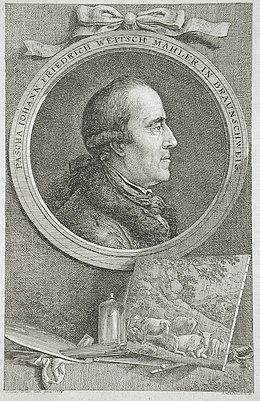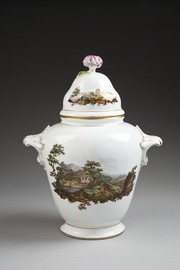Pascha Johann Friedrich Weitsch
Pascha Johann Friedrich Weitsch (born October 16, 1723 in Hessendamm , † August 6, 1803 in Salzdahlum ) was a German landscape painter and draftsman .
Life
He was the son of the bricklayer Daniel Weitsche († 1754) and the early deceased mother Anna Margaretha († 1737). The first name Pascha is traced back to his godfather Pasche Wipperling and was a local abbreviation for Paschalis . He attended the Latin school in Osterwieck for a short time and then worked as a writer in Wolfenbüttel . After three and a half years, he entered the service of Captain von Blum in Braunschweig , before becoming a soldier in 1744.
Activity as an artist

Weitsch trained during his military service, self-taught in the artistic field, u. a. through the copying of paintings that he in 1756, so successful porcelain painter in the manufactory Fürstenberg was. Since the 1760s he also created oil paintings, which mostly show landscapes of the Braunschweig region and the Harz Mountains .
In 1780 Weitsch undertook a journey through the Harz Mountains with Johann Heinrich Ramberg , whose album with a dozen "Views from the Harz Mountains" laid the foundation for the study and scholarship of the later famous painter.
Weitsch worked temporarily as an art dealer and for several decades worked as a painter and trainer for the Stobwassersche lacquerware factory in Braunschweig. He went on study trips to Kassel , Amsterdam and Bruges . In 1789 he was appointed inspector of the picture gallery in the ducal castle of Salzdahlum . He took a great part in Braunschweig's intellectual life and corresponded with Gleim and Lessing .
Weitsch died in Salzdahlum in 1803. He had been married to Anna Stoppen since 1748, after whose death he married Sophie Helmkampf in 1783. His son Friedrich Georg Weitsch (1758–1828) also worked as a painter and portrayed his father in 1797 in an oil painting that is now in the possession of the Herzog Anton Ulrich Museum . His younger son Johann Anton August Weitsch (1762–1841) was also a painter and followed his father in 1803 as gallery inspector in Salzdahlum Castle.
Honors
In 1784 he was appointed a member of the Düsseldorf Art Academy . He was appointed a member of the Prussian Academy of the Arts in Berlin in 1795.
Works
One of his most important works on porcelain is a table service with landscape motifs for Duke Karl I of Braunschweig from 1768/1769 . The Herzog Anton Ulrich Museum owns 216 drawings by Weitsch.
Paintings (selection)
- The Bode valley with the horse bustard , 1769 (Herzog Anton Ulrich Museum)
- Motif from the Querum oak forest , 1792 (Herzog Anton Ulrich Museum)
Other works are in the possession of the Braunschweig Municipal Museum .
literature
- Paul Zimmermann : Weitsch, Friedrich . In: Allgemeine Deutsche Biographie (ADB). Volume 41, Duncker & Humblot, Leipzig 1896, pp. 626-629.
- Pascha Johann Friedrich Weitsch . In: Hans Vollmer (Hrsg.): General lexicon of fine artists from antiquity to the present . Founded by Ulrich Thieme and Felix Becker . tape 35 : Libra-Wilhelmson . EA Seemann, Leipzig 1942, p. 350-351 .
- Anette Boldt-Stülzebach: Weitsch, Pascha Johann Friedrich. In: Horst-Rüdiger Jarck , Günter Scheel (ed.): Braunschweigisches Biographisches Lexikon - 19th and 20th centuries . Hahnsche Buchhandlung, Hannover 1996, ISBN 3-7752-5838-8 , p. 644-645 .
- Jochen Luckhardt : Pascha Johann Friedrich Weitsch. In: Luitgard Camerer , Manfred Garzmann , Wolf-Dieter Schuegraf (eds.): Braunschweiger Stadtlexikon . Joh. Heinr. Meyer Verlag, Braunschweig 1992, ISBN 3-926701-14-5 .
- Annedore Müller-Hofstede: The landscape painter Pascha Johann Friedrich Weitsch 1723-1803. (= Braunschweiger Werkstücke , Volume 48.) Braunschweig 1973.
Web links
- Literature by and about Pascha Johann Friedrich Weitsch in the catalog of the German National Library
Individual evidence
- ↑ "we also learn that the first name pascha". In: google.de. Retrieved May 21, 2016 .
- ↑ a b Four Quarter Cult. (PDF) In: sbk-bs.de. Braunschweigischer Kulturbesitz Foundation , p. 31 , accessed on May 21, 2016 .
- ^ Weitsch, Friedrich in the German biography
- ^ Alheidis von Rohr: Ramberg, Johann Heinrich. In: New German Biography (NDB). Volume 21, Duncker & Humblot, Berlin 2003, ISBN 3-428-11202-4 , p. 128 f. ( Digitized version ).
| personal data | |
|---|---|
| SURNAME | Weitsch, Pascha Johann Friedrich |
| ALTERNATIVE NAMES | Weitsch, Friedrich |
| BRIEF DESCRIPTION | German landscape painter |
| DATE OF BIRTH | October 16, 1723 |
| PLACE OF BIRTH | Hessendamm |
| DATE OF DEATH | August 6, 1803 |
| Place of death | Salt dahlum |



